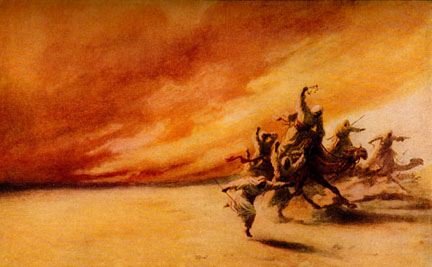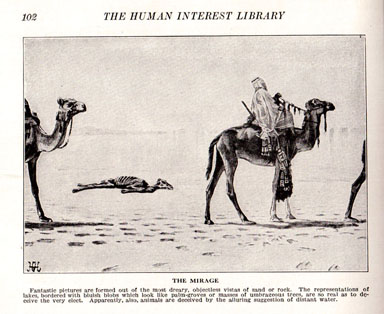
Exactly 90 years ago a four-volume set of encyclopedia-like human interest books was published as The Human Interest Library: Visualized Knowledge by Midland Press in Chicago. In a previous post I commented on its thoroughly “Orientalist” flavor. Not only was the Sahara portrayed as a barren landscape with people who have nothing to do, but the only winds of change are violent storms summed up in the Anglicized “simoon.” Above is an image from the frontispiece to volume 2 in the series and entitled “The Dreaded Simoon – The Scourge of the Desert”. I have not been able to find the name of the artist, which is clearly pre-1921. The caption reads: “The fury of the simoon is like the blast of a furnace. Winged with the whirlwind. and charioted with thunder, it blasts everything in its course. It has the appearance of a train of fire whose murky smoke fills the whole wide expanse of the desert.”
Here is the text describing “The Scourge of the Desert” (Vol. 4, p. 97):
As the color plate shows, the simoon, described by writers, must have presented a majestic and awe-inspiring spectacle. Its advent was usually signaled by the appearance of a rapidly spreading haze extending from the horizon till the whole sky was obscured by it. Then a hurricane, blowing from the south or east, drive columns of heated sand before it. There was no escape from its red scourge. Even at a distance from the actual storm “the eyes become red, swelled, and inflamed, the lips and skin burnt and chapped, while severe pain in the chest is generally felt in consequence of the quantities of sand unavoidedly inhaled.”
The Sahara Desert again and again presents the vivid contrast of Hell and Paradise…

Not only does the desert wreak sedimental havoc, but it also teases the mind without mercy with the mirage. Above is the image presented of a mirage. Here is how the image is explained (volume 2, p. 103):
Among the natural phenomena connected with the Sahara, (and other deserts) which has seized ont he popular imagination, is that of the mirage. The sand abnormally heated by the fierce sunshine, sets up a current of heated air which expands and has its refractive index altered in such a way as causes it immediately above the sand or rocks to become a mirror. Distant objects seen through this air are enlarged and doubled and the reflection of the sky on this surface of sun-baked ground appears like a lake. It is possible even that objects below the horizon are reflected upwards and made visible so that fantastic pictures are formed out of the most dreary, objectless vista of sand and rock. The representations of lakes bordered with bluish blobs which look like palm groves or masses of umbrageous trees are so real as to deceive the very elect. Apparently also the mirage is visible to the sight of horses, oxen and camels. who are allured by the deceptive suggestion of distant water. The only feature about the mirage which is suspicious is the very indeterminate edge of the water in the middle distance. You never see a well defined shoreline on the nearer side of the supposed lake. But as this appearance occurs along the shores of real sheets of water int he desert and is due to the glare of the sun on the wet sand or mud, it seldom disturbs the illusion of the mirage.
to be continued…